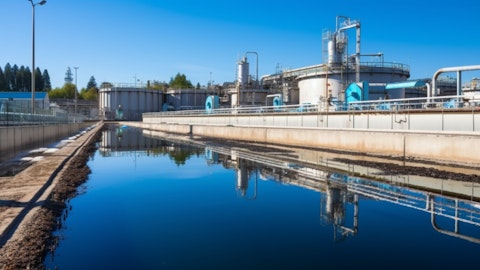Krispy Kreme, Inc. (NASDAQ:DNUT) Q3 2025 Earnings Call Transcript November 6, 2025
Krispy Kreme, Inc. misses on earnings expectations. Reported EPS is $-0.1136 EPS, expectations were $-0.06.
Operator: Hello, everyone, and thank you for standing by. My name is Ellie, and I will be your conference operator today. At this time, I would like to welcome everyone to the Krispy Kreme Third Quarter 2025 Earnings Call. [Operator Instructions] I would now like to turn the call over to Christine McDevitt, Krispy Kreme Associate General Counsel. Please go ahead.
Christine McDevitt: Hello, everyone, and welcome to Krispy Kreme’s Third Quarter 2025 Earnings Call. Thank you for joining us today. This morning, Krispy Kreme issued its earnings press release for the third quarter of fiscal 2025. The press release and an accompanying presentation are available on our Investor Relations website at investors.krispykreme.com. Joining me on the call are President and Chief Executive Officer, Josh Charlesworth; and Chief Financial Officer, Raphael Duvivier. After their prepared remarks, we will host a question-and-answer session. But before we begin, please note that during this call, we will be making forward-looking statements pursuant to the safe harbor provisions of the Private Securities Litigation Reform Act of 1995, including statements of expectations, future events, or future financial performance.
Forward-looking statements involve a number of risks, assumptions, and uncertainties, and we caution investors that many factors could cause actual results to differ materially from those contained in any forward-looking statements. These factors and other risks and uncertainties are described in detail in the cautionary statements in our earnings press release, our annual report on Form 10-K filed with the SEC and in other SEC filings we make from time to time. Forward-looking statements represent our expectations only as of today, and we assume no obligation to publicly update or revise any forward-looking statements, except as may be required by law. Additionally, during this call, we will reference certain non-GAAP financial measures. Please refer to our earnings press release on our website for additional information regarding those non-GAAP measures, including a reconciliation to the closest comparable GAAP measures.
Raphael will take us through our quarterly financial performance in a moment. But first, here’s Josh.
Joshua Charlesworth: Thank you, Christine, and good morning, everyone. I am pleased with the early progress we are making on our turnaround plan to deleverage the balance sheet and deliver sustainable, profitable growth as reflected in our third quarter performance. As a reminder, we are focused on: one, refranchising; two, improving returns on capital; three, expanding margins; and four, driving sustainable, profitable U.S. growth. First, refranchising enables us to more profitably drive system-wide sales growth and accelerate unit development through our capital-light franchise model. We are already working toward refranchising certain international markets as we look for experienced long-term potential partners to operate and expand our iconic brand around the world.
We also plan to restructure our joint venture in the Western U.S. with the WKS Restaurant Group, which today represents approximately 15% of our U.S. revenues. Restructuring is expected to reduce our ownership to a minority stake. We are happy with the strength of our operations in the WKS joint venture and look forward to future capital-light expansion across 10 Western U.S. states. Proceeds from international refranchising and the WKS restructuring are expected to be used to reduce net debt. Second, our focus on improving returns on capital involves reducing capital intensity by leveraging existing assets and focusing on franchise development. As part of this approach, we have lowered our CapEx spending for the back half of 2025 compared to the first half of the year.
And in aggregate, annual CapEx will be significantly below 2024 levels. In the U.S. next week, we will open our Hot Light Theater Shop and production hub in Minneapolis, bringing Krispy Kreme to an area where fans have been eagerly anticipating our arrival. Overall, though, we have reduced investment in building new hubs, preferring to leverage existing excess capacity for growth where available. Looking ahead to 2026, we plan to reduce CapEx investment compared to 2025. We also expect our international franchise pipeline to continue to be a source of capital-light growth in the years ahead. For example, through our franchisees and minority joint ventures, we recently opened our first Hot Light Theater Shop in Madrid, Spain. We’ll soon enter Uzbekistan and have announced further expansion in Brazil.
Future international growth is expected to come not just from new shop openings with franchisees, but also through fresh delivery door expansion in grocery, convenience, club wholesalers and quick service restaurants. For example, our collaboration with KFC in the UAE has now expanded to more than 200 KFC restaurants offering Krispy Kreme doughnuts. This reflects the success of the model and the potential for future growth. Third, to expand margins through greater operational efficiency, the business model is being simplified. U.S. operations have been strengthened under the leadership of Chief Operating Officer, Nicola Steele, and costs across the P&L are being reduced. First, doughnuts are being made more efficiently by optimizing production, streamlining hub activities, and improving labor productivity.
These initiatives are expected to maximize capacity, enhance operations and guest experience and increase profitability through better labor management. Second, doughnuts are being delivered more efficiently by improving route management and demand planning and by testing adjusted production and delivery schedules to support cost-effective expansion. These efforts are further strengthened by the capabilities of our third-party logistics partners whose expertise in fleet management, delivery technology and safety now supports approximately 54% of our U.S. network. Outsourcing has already resulted in more predictable logistics costs, and we expect to fully outsource U.S. delivery in 2026. And third, the benefits of reduced headcount and costs that we previously announced are decreasing both operating expenses and SG&A.
Finally, to drive sustainable, profitable growth in the U.S., we are focused on strategic customers with high volume and high-margin doors, ensuring that we have the right product variety in the right amount, in the right place and at the right time. We continue to grow with strong existing customers. During the third quarter, more than 200 profitable doors were added with strategic partners, including Target, Costco, Sam’s Club, Kroger and Publix. In total, approximately 1,000 profitable doors have been added year-to-date, and these doors are delivering weekly sales well above the system average. At Walmart, we are seeing the benefit of additional shelf space combined with our current merchandising towers and cabinets as well as placement on Walmart’s website.

Early results demonstrate higher sales at current stores while supporting incremental distribution and new stores. So far, we only serve about 30% of Walmart’s total domestic footprint. So there is a considerable opportunity ahead of us. Our marketing continues to emphasize the original glaze donut, our most iconic, most affordable, and most profitable product, while leveraging digital channels to engage consumers and further amplify sales. The excitement around our signature core product is coupled with innovative limited time offerings that are culturally relevant and tied to buzzworthy events. Third quarter examples include our Harry Potter and Passport to Italy collections as well as our collaboration with Crocs. In the fourth quarter, we are also pleased with our successful Halloween campaign.
These limited time offerings performed particularly well in our digital channel. In the third quarter, U.S. digital sales increased 17% year-over-year and represented more than 20% of U.S. retail sales. Our heightened traction in this channel reinforces digital as a key driver of profitable growth and a highly valued means for connecting with U.S. consumers. In addition, we recently announced a refresh of our everyday doughnut menu, featuring trending flavors, fan favorites requested on social media and returning popular doughnuts. Our updated offerings provide more variety for consumers while reinforcing the strength of our core menu. Our turnaround plan to drive sustainable, profitable growth and reduce debt leverage is showing progress, and I’m confident that we can deliver on our objectives and achieve compelling results.
Our long-term success will be built upon the strength of our leadership and field teams whose talent and commitment to operational excellence continue to inspire confidence. I’m especially encouraged by how our new CFO has seamlessly taken off his role, providing strategic financial leadership that complements the operational expertise of our teams. With that, Raphael will now review our third quarter financials.
Raphael Duvivier: Thank you, Josh. Through our comprehensive turnaround plan, we have pivoted to better position ourselves for sustainable, profitable growth. As I mentioned in August, my immediate focus as CFO is deleveraging the balance sheet, improving profitability in the U.S. during the second half of this year and leading our refranchising efforts to evolve Krispy Kreme to a more capital-light franchise model. The third quarter provided us with an encouraging start as we grew adjusted EBITDA 17% year-over-year or 20% if you exclude the sale of our majority stake in Insomnia Cookies in the third quarter of 2024. Adjusted EBITDA was $40.6 million in the third quarter, more than double what we saw in the second quarter. We also delivered positive free cash flow of $15.5 million.
These results reflect the early progress we are making on our turnaround plan, reducing our net leverage by 20 basis points compared to second quarter. We have excess liquidity of over $200 million as of the third quarter, which I believe provide us with the flexibility to meet both short-term obligations and long-term investments as we continue to implement our turnaround plan. Net revenue for the quarter was $375.3 million with 0.6% organic revenue growth driven by the International segment, offset by the strategic closure of underperforming doors, primarily in the U.S. Total net revenue declined by 1.2% compared to last year, largely due to the sale of a majority stake of Insomnia Cookies. Adjusted EBITDA was $40.6 million, up from $34.7 million last year.
We generated nearly as much adjusted EBITDA in the third quarter as we delivered in the first half of 2025. These results were positively impacted by productivity initiatives, SG&A savings, and the removal of costs from the now ended McDonald’s USA partnership, combined with recoveries from business interruption insurance related to the 2024 cybersecurity incident. Turning to the U.S. segment. Organic revenue growth declined 2.2%, in part due to the exit of approximately 600 unprofitable doors. During the third quarter, we also exited approximately 2,400 doors connected to the now ended McDonald’s USA partnership. As Josh mentioned, we also have added doors to deliver substantially higher average weekly sales. Sequentially, this store optimization has resulted in an 18% increase in average weekly sales to $617 per door, demonstrating the traction we have when our products are in the right place with the right partner.
Adjusted EBITDA was $21 million in the quarter, up from $13.9 million in the third quarter of last year. We benefit from cost savings related to operational efficiencies at our retail shops and our logistic outsourcing initiatives in addition to cyber-related insurance recoveries of $9.3 million. Excluding those cyber-related insurance recoveries, U.S. adjusted EBITDA increased sequentially $1.8 million despite approximately $3 million of lagging costs early in the quarter related to the now ended McDonald’s USA partnership. This demonstrates solid improvement resulting from our turnaround planned initiatives. Within our company-owned international markets, organic revenue grew 6.2%, driven by growth in Canada, Japan, and Mexico. These markets continue to see the benefit of strategically rolling out our hub-and-spoke model.
International segment adjusted EBITDA increased by $0.4 million or 1.7% to $23.2 million, driven by Japan and Mexico. This is the first time, in the last 4 quarters, we saw year-over-year adjusted EBITDA growth in this segment. The margin decline of 90 basis points to 16.5% was due to the ongoing turnaround in the U.K., where we saw a strong sequential improvement in adjusted EBITDA as the U.K. leadership team continues to make progress. In the Market Development segment, organic revenue declined 5.3% as growth in royalty revenues from international markets was more than offset by lower product sales and limited equipment sales in the quarter. Adjusted EBITDA was $12 million with a margin rate of 63.5%, up 930 basis points year-over-year. Shifting back to our consolidated results, adjusted EBITDA and working capital management strengthened cash flow.
We generated $42.3 million in operating cash flow during the third quarter and $15.5 million in free cash flow following 2 quarters of cash outflows in the first half. Our bank leverage ratio was 4.5x at the end of the quarter, which is below the 5x leverage ratio limit in our credit facility. Our net leverage ratio, which reflects our net debt divided by trailing 4 quarters adjusted EBITDA was 7.3x, down from 7.5x as of last quarter, positively impacted by the adjusted EBITDA improvement. Josh outlined several steps we are taking to increase profitability. We have already started to see the benefit of an estimated $12 million to $15 million of annualized SG&A cost savings along with productivity improvements at retail shops and efficiencies through third-party logistics.
All of these items are already having a tangible impact on our financial condition. Sequentially, we saw working capital improvement across our balance sheet, including accounts receivable, accounts payable and inventories. While we’re encouraged by this progress, we are mindful of continued consumer softness in the marketplace and are managing through these conditions with discipline. We must remain focused on deleveraging the balance sheet as we move towards our capital-light franchise model. With that, I’ll turn it over to Josh for his closing remarks.
Joshua Charlesworth: Thanks, Raphael. In summary, we are making progress on our comprehensive turnaround plan to deleverage the balance sheet and deliver sustainable, profitable growth. We are focused on refranchising, improving returns on capital, expanding margins, and driving sustainable, profitable U.S. growth. I am confident in our ability to capitalize on the significant growth opportunity ahead and share the joy of Krispy Kreme with more people in more places around the world. Operator, let’s now open it up for Q&A, please.
Q&A Session
Follow Krispy Kreme Inc. (NASDAQ:DNUT)
Follow Krispy Kreme Inc. (NASDAQ:DNUT)
Receive real-time insider trading and news alerts
Operator: [Operator Instructions] Your first question comes from the line of Daniel Guglielmo of Capital One Securities.
Daniel Guglielmo: You all mentioned great momentum in the International segment, and we have seen international strength versus the U.S. for other global brands this earnings season. Are you seeing continued strong trends in those markets for 4Q? I think you mentioned Japan and Mexico adjusted EBITDA growth this year — this quarter.
Raphael Duvivier: This is Raphael. I can take the question. Thank you for the question. Yes, we did see, and as you can see from the results in international, we saw year-over-year growth, but also more important, a growth in the quarter, which we have not seen in the past quarters. We continue to see good momentum. You mentioned Mexico and Japan, they continue to deliver, but also the markets that we don’t own, the international franchise markets, we continue to see growth in places like Brazil, where we’ve just opened and the places that we’re actually planning to open. So we continue to see strong momentum there.
Daniel Guglielmo: Okay. Great. I appreciate that. And then I think in the commentary, it seemed like there is going to be some DFD expansion in some of the international markets. Can you just talk about some learnings that you’ve taken away from the U.S. expansion that you’re going to kind of think about as you’re doing this expansion in international? It would just be helpful to understand.
Raphael Duvivier: Yes, it’s a great question. Look, we learned a lot with DFD over the years. And as we expand internationally, we have the hub and spoke in mind. So as we go in places where we already have the DFD in place internationally, think about U.K., think about Mexico, Japan, but also the places we’re expanding now, once again, new countries like Brazil or France, we are taking all those learnings. We know better and better what works. And it’s interesting. When the brand is in the right place with the right partner, we see how DFD and the hub and spoke can operate very well.
Operator: Your next question comes from the line of Brian Harbour of Morgan Stanley.
Brian Harbour: I guess maybe can you just comment on sort of the U.S. demand environment as you saw in 3Q and kind of what’s important here?
Joshua Charlesworth: Yes, I’ll take that. Q3 was very interesting for us because the results reflect the progress on our turnaround plan. Think about it, we intentionally exited from McDonald’s restaurants and another 600 poor performing doors. So overall, that contributed to a small revenue decline, but a significant improvement in EBITDA and positive cash flow. So it was clearly the outcome of our actions, the rationalization program, though on U.S. doors is over. So instead, we continue to focus on high-volume, profitable doors going forward with strategic partners. We’ve actually added 1,000 of those year-to-date with people like Walmart, Target and Costco. And that’s resulted in average weekly sales jumping back up over $600.
So that is about the future. We intended to have that reduction in growth in the third quarter to drive the turnaround plan. Underlying all that, we’re actually seeing U.S. trends improving. The consumer response, in particular to our specialty doughnut campaigns, we had Harry Potter in the late summer and just saw a successful Halloween means that my confidence in Krispy Kreme’s long-term sustainable profitable growth is high.
Brian Harbour: Okay. What — I guess, what additional cost things should we expect here just since the end of the year? And I know you’re not guiding, right, but do you think that — do you want to make any comments about where you think EBITDA could be in the fourth quarter?
Raphael Duvivier: Yes, I can take this. This is Raphael. Look, we saw a sequential improvement in EBITDA in Q3 as we saw in Q2 and are happy with the progress we made. The turnaround plan is working. And we continue to believe that as we enter Q4, we’ll see sequential EBITDA improvement. As I said, we’re not providing guidance, but we do expect Q4 EBITDA to be higher and to still be able to generate a positive cash flow in Q4.
Operator: The next question comes from the line of Sara Senatore of Bank of America.
Sara Senatore: Isaiah Austin on for Sara. My first question is around the comment on fully outsourcing U.S. delivery in 2026. Do you guys mind talking through the P&L implications? Does that create a lower cost per delivery or just a more like variable cost structure so that you don’t need as much volume to lever expenses? And then I have a quick follow-up.
Joshua Charlesworth: Yes, sure. This is an important program for us through our turnaround. You’re right, we’re now — 54% of the network is outsourced to third-party providers, and we expect that to be the whole network in 2026. What we see is very high service levels. We’re very pleased with the partners as we roll this program out. For now, on your P&L question, it’s ensuring we have more predictable costs but interestingly, we see it as, in the long term, providing us a tailwind. If you recall, earlier in 2025, late ’24, we were seeing the impact of casualty losses, and that exposure is reduced going forward. We also expect with the expertise of these partners who are focused every day on moving our doughnuts as logistics experts as opposed to us ourselves being the producers of the doughnuts, we expect operational improvements over time.
They’ve already been identifying and sharing with us ideas around how they can use their technology and expertise to improve route management, for example. So a long-term tailwind for us. But for now, the impact on the P&L is more just ensuring we have predictable costs without any of the surprises of those casualty losses.
Sara Senatore: Excellent. And then just as a follow-up, just thinking about the recently announced expanded core menu lineup, just want to know like what prompted that change? And how do you all think about balancing variety versus complexity?
Joshua Charlesworth: Yes. I mean it reflects — we talk about long-term sustainable, profitable growth. That’s seen us really focus on our core business. And there’s nothing more core than our fresh doughnuts board at our doughnut shops across America. And we’ve been highlighting the original glazed itself, adding flavored glazes like chocolate glaze, strawberry glaze. But we also saw that we haven’t refreshed and updated our assorted doughnut menu for many years. And we get a lot of input from consumers, social media, in particular, pointing out that there are favorite doughnuts from the past or even favorite ideas that they have that they would love to see. So we’ve been listening to the consumer. You’ll see we’ve brought out with this new refreshed range, OREO Cookies with Kreme and New York Cheesecake, my favorite, the Biscoff Cookie Butter.
And that’s a response to consumer demand. Now we also think — we’ve also done that. We’ve been really thoughtful about making sure that consumers have a good amount of choice and get a really awesome experience when they come to the Krispy Kreme Doughnut shop, all in the context of our turnaround plan, focusing on what we do best, making awesome doughnuts. And we’re really looking forward to the impact of that.
Operator: [Operator Instructions] Your next question comes from the line of Rahul Krotthapalli of JPMorgan.
Rahul Krotthapalli: Josh, you have a large brand presence or brand equity that is probably even bigger than the company as many would say today. I mean discuss the growing supply or competition in the segment as we see a number of cake and cookie and other sweet treat brands in the market. And at the same time, many consumers are also being more mindful of spending generally and then also more conscious around the segment. Any thoughts you could like to share there? And then I have a follow-up.
Joshua Charlesworth: Yes. We’re very proud of the strength of the brand, both in terms of awareness and also in terms of what it means to people, particularly in sharing occasions, gifting occasions, makes us quite unique compared to others. It’s a relatively infrequent purchase, just 2 or 3 times a year. So we don’t really get impacted by those things. Instead, we find what’s most important is making sure we really come with an awesome doughnut experience with our original glaze, most famously with the hot doughnut and continuously bringing news, as I just mentioned a moment ago, with innovation, specialty collections and being relevant at those important times of the year. I mean we’re in hot doughnut season right now. It’s really important that we saw a good response to the brand at Halloween and the whole holiday period coming up is an important one for us. So that’s where we are focused, bringing moments of joy that people can share and enjoy with us.
Rahul Krotthapalli: And the follow-up is on the retooling the distribution network. I know you are like taking a full look on the entire DFD touch points now. Is there any changes to the thought process on kind of brands and partnerships you want to focus on going forward? Are we — where are we in the journey there? And then also, is there any change in the kind of agreements or how you want to execute the drop-offs in this new model?
Joshua Charlesworth: So we’re continuously looking to improve our distribution network, looking at delivery timing, making sure that we are producing the doughnuts in close proximity to our customers, but also efficiently. So we really are doing a lot of work around that as part of our turnaround and continue to expect benefits from that. The big initiative for us was to exit from low-traffic doors. We had — over time, we identified there were about 1,400 doors in the U.S. where the traffic wasn’t high enough, and therefore, the weekly sales were good enough. And so we intentionally exited from those this year, but that program is done. So going forward, to your broader question, it is about expanding convenience and access to the brand.
But only where the traffic is high enough and in-store visibility is really clear. That’s when the conditions are right for us. What’s great is we have several customers that already qualify against that. And they have plenty of upside opportunity. It’s only recently in the last year or so that we entered Target, and we’re really just starting out with Costco as 2 clear examples of that. And even more recently just got going with Sam’s Club. So we have plenty of customers where we can go that are sort of proven with that high traffic. It’s interesting and internationally that we see some other innovations such as the KFC we’re seeing in the Middle East. But really in the U.S., the focus is on these big high-traffic locations in which we have plenty of runway, and they can support our long-term sustainable profitable growth.
Operator: Your next question comes from the line of Alexandra Gaillard of BNP.
Alexandra Gaillard: This is Jaafar Mestari from BNP. Just wanted to clarify one thing in terms of the outlook where you talk about the remainder of 2025, you expect to see further improvement in adjusted EBITDA. Does that mean a Q4 ’25 EBITDA higher sequentially than Q3? Is that a Q4 ’25 EBITDA higher year-on-year than Q4 last year? Or is there any other way we should look at this?
Raphael Duvivier: I can take this. This is Raphael. Yes, that’s the way you should read this. We do expect to see improvement in Q4 versus Q3 and also positive cash flow in Q4 as we generated in Q3. And as to 2026, we’re still not providing guidance, but you can expect sequential improvement in EBITDA. And as I said, in Q2, we continue to focus on lowering CapEx spend. We will do this in the second half of this year, and we will lower CapEx for next year as well.
Operator: Thank you. There are no further questions. I’d now like to hand the call back to the CEO, Josh, for final remarks.
Joshua Charlesworth: Well, thank you, everyone, for your interest in Krispy Kreme today. We saw we implemented a turnaround plan this summer to drive sustainable profitable growth and deleverage the balance sheet, and we are already seeing that turnaround underway. It’s thanks in large part to our great Krispy Kreme team all over the world. So I thank you as well. Thank you. Goodbye.
Operator: Thank you for attending today’s call. You may now disconnect. Goodbye.
Follow Krispy Kreme Inc. (NASDAQ:DNUT)
Follow Krispy Kreme Inc. (NASDAQ:DNUT)
Receive real-time insider trading and news alerts



